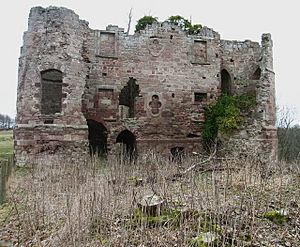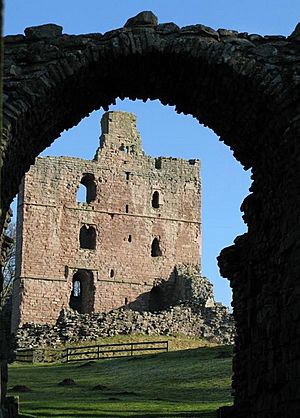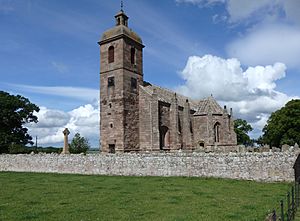Pedro de Ayala facts for kids
Quick facts for kids Most Reverend Pedro López Ayala |
|
|---|---|
| Bishop of Islas Canarias | |
| Church | Catholic Church |
| Diocese | Diocese of Islas Canarias |
| In Office | 1507–1513 |
| Predecessor | Diego de Muros |
| Successor | Fernando Vázquez de Arce |
| Personal details | |
| Died | 31 January 1513 Canary Islands, Spain |
Don Pedro de Ayala (died 31 January 1513) was an important Spanish diplomat in the 1500s. He worked for Ferdinand II of Aragon and Isabella I of Castile, the King and Queen of Spain. His main jobs were at the courts of James IV of Scotland and Henry VII of England. In Scotland, he helped with the King's marriage plans and a big problem caused by a man named Perkin Warbeck. Later, in England, he supported Catherine of Aragon. Pedro de Ayala was also a church leader, becoming the Bishop of the Canary Islands.
Not much is known about Pedro de Ayala's early life from English records. We do know he came from a noble family in Toledo. A historian who knew him, Polydore Vergil, said he was clever but not a great scholar.
Contents
- Diplomatic Missions: Helping Spain's Kings and Queens
- Mission to Portugal: Drawing the Line
- Mission to Scotland: A Royal Friendship
- A Spanish Ambassador in Scotland
- Invading Northumbria: A Diplomat on the Battlefield
- Peace Talks: Ayala and Richard Foxe
- Castle Sieges: A Diplomat's Presence
- Treaty of Ayton (1497): Making Peace Last
- Spanish Ambassador in London: A New Role
- Rivalry and Influence: Ayala's Later Career
- Final Years: A Legacy of Diplomacy
- In Fiction: A Character in a Play
Diplomatic Missions: Helping Spain's Kings and Queens
Mission to Portugal: Drawing the Line
In November 1493, Don Pedro de Ayala and Don Garcí Lopez de Carbajal went to meet King John II of Portugal. Their job was to discuss where Spain and Portugal could explore by sea. This was very important because Spain was sponsoring Christopher Columbus's voyages. The Spanish ambassadors suggested that the Pope should decide the boundary.
King John II was not happy about this meeting or Columbus's latest trip. He even showed off his cavalry, perhaps to scare them. He also made fun of Don Pedro for his limp. Later, in March 1494, a second meeting between Portugal and Spain was more successful. It led to the Treaty of Tordesillas, which set new rules for exploration.
Mission to Scotland: A Royal Friendship

Before Pedro de Ayala arrived, Scotland had seen a few Spanish visitors. In 1489, Don Martin de Torre was welcomed at Linlithgow Palace. He brought gifts for King James IV, like a sword and a dagger. He even brought Spanish dancers to Edinburgh in 1491!
In 1495, Martin returned with a colleague, Garcia de Herrara. They had secret instructions about King James IV possibly marrying a Spanish princess. James read these instructions, which showed Spain wasn't very keen on the idea. Despite this, they stayed and even attended the wedding of Perkin Warbeck to Lady Catherine Gordon. Perkin Warbeck claimed to be an English prince, which caused a lot of trouble.
James IV sent the Spanish visitors back to Spain with gifts, including horses and hunting dogs. Spain already had an ambassador in London, Dr Rodrigo Gonzalez. He was working on an important alliance between Spain and England. This alliance would be sealed by the marriage of Catherine of Aragon to Arthur, Prince of Wales, the English prince.
A Spanish Ambassador in Scotland
In 1496, James IV was pleased to welcome Don Pedro de Ayala as a permanent Spanish ambassador. This was a big deal because Spain only had permanent ambassadors in a few important places like Rome and London. James even paid some of Ayala's living costs and gave him a house in Edinburgh.
Ayala's mission was tricky. He was told to make James IV think he might marry Catherine of Aragon. But Spain knew she was already promised to Prince Arthur of England. Ayala's main goal was to stop Perkin Warbeck from causing war between Scotland and England. Warbeck claimed to be an English royal, and James IV was supporting him. This threatened Spain's alliance with England.

Pedro de Ayala worked hard to become friends with James IV and to weaken Perkin Warbeck's influence.
Invading Northumbria: A Diplomat on the Battlefield
Ayala even went with the Scottish army to the English border twice. He crossed the Tweed into Northumbria with Perkin Warbeck on September 21, 1496. Four of his Spanish servants were killed in the fighting. The Scots destroyed some small towers and then left when an English army approached.
Later, the Spanish King and Queen were told that Ayala wasn't there during this invasion. They wished he had been there to stop it.
Peace Talks: Ayala and Richard Foxe
By March 1497, Spain wanted to avoid war between England and Scotland. Ayala's job was to help make peace. He met with Richard Foxe, the Bishop of Durham, who represented Henry VII of England. James IV still refused to hand over Perkin Warbeck.
Henry VII wasn't happy with the peace offers. He wanted Perkin Warbeck to be given to him before any more talks. Soon after, James IV changed his mind. Perkin Warbeck left Scotland around July 7. This showed Ayala's success in getting Perkin to leave.
Castle Sieges: A Diplomat's Presence


Even after things seemed calm, James IV ordered his big cannons, including Mons Meg, to be taken to the border. They aimed at Bishop Foxe's Norham Castle. Pedro de Ayala was present during the siege in August 1497. The King even played cards with Ayala during the siege!
James IV eventually gave up the siege and returned to Edinburgh. Then an English army arrived and took Ayton Castle. After a few days, James IV agreed to a truce. The King played cards with Ayala again at Stirling Castle in September 1497.
Treaty of Ayton (1497): Making Peace Last
Don Pedro de Ayala played a key role in negotiating the peace treaty between England and Scotland. It was signed at the church of Ayton on September 30, 1497. Ayala acted as the representative for the Scottish King.
The treaty created a seven-year truce between the two countries. It also set rules for shipping and trade. Border officials were given new powers to deal with criminals. Both Kings agreed not to help each other's rebels. The treaty also said that Spain's King Ferdinand and Queen Isabella would help solve any future problems. James IV signed the treaty in February 1498. Ayala also helped extend the treaty in March 1498.
Spanish Ambassador in London: A New Role
In October 1497, Pedro de Ayala left Scotland for England. He was given gifts from King James IV. In London, Ayala presented his official papers to Henry VII. Perkin Warbeck, who had been captured, was also there.
Ayala might have returned to Scotland briefly. Records show him playing tennis with the King in Stirling in April 1498. But by May 1498, he was in England, calling himself the "Spanish ambassador to Scotland in London on business."
In London, Pedro de Ayala made many connections. He advised other diplomats on how to send letters to James IV in Scotland. He suggested copying letters to important Scottish leaders. Ayala stayed in London and did not return to Scotland. James IV still trusted Ayala a lot. He kept asking Ayala to come back to Scotland to advise him on his marriage to Margaret Tudor. Ayala helped finish the Anglo-Scottish treaty in July 1499, even though he probably didn't go back to Scotland in person.
Rivalry and Influence: Ayala's Later Career
Even though the Ayton treaty was a success, Henry VII of England was worried about some of Ayala's actions. But Spain was happy that Perkin Warbeck was captured and that Ayala had made peace. At the same time, Ayala's colleague, Dr Rodrigo Gonzalez de Puebla, arranged the marriage of Catherine of Aragon to Prince Arthur.
Dr Puebla, however, didn't like Ayala being in London. He wanted Ayala to be sent home. There were even stories that Ayala's servants fought in the streets of London. Ayala's Scottish chaplain was arrested for murder. Other Spanish ambassadors arrived and saw that Ayala was popular at the English court. They asked him to tell the Spanish King and Queen about Scotland.
Both ambassadors stayed in London. Pedro de Ayala's report on Scotland from July 1498 is a very important source of information about James IV. He suggested that Spain and Scotland should become allies through marriage. He thought James IV should marry the Infanta Maria of Aragon, not Margaret Tudor of England. He described Margaret as young, small, and sickly. Ayala also mentioned John Cabot's voyage from Bristol towards America.
Catherine of Aragon: A Princess's Troubles

Henry VII of England gave Ayala money and asked him to stay in London until Catherine of Aragon arrived. Dr Puebla wrote to Spain that Henry VII's advisors thought Ayala was useful to England because he caused problems for Puebla. Ayala also wrote to Spain, accusing Dr Puebla of working with Henry VII about Catherine's jewels.
On January 25, 1502, Ayala attended the marriage ceremony of James IV to Margaret Tudor at Richmond Palace. Perkin Warbeck's widow, Lady Catherine Gordon, was also there.
After the Scottish royal marriage, Ayala was called back to Spain. Henry VII gave him a leaving gift of £200. Ayala also received two important church jobs in London. He was sent to Flanders, but by 1503, Queen Isabella regretted his move. Ayala returned to England in March 1506. The Venetian ambassador reported that Ayala's actions were worrying Philip I of Castile, who thought Ayala was advising Philip's wife, Joanna of Castile, behind his back.
Catherine of Aragon was unhappy with how her father-in-law treated her, especially regarding her money. Ayala was rewarded with the Bishopric of the Canary Islands in 1507. Henry VII also arranged for him to be Archdeacon of St Paul's.
Final Years: A Legacy of Diplomacy
When Henry VIII wanted to see Don Pedro again in 1509, he was too sick. Pedro was a church leader in Toledo, Spain. He died in January 1513 and was buried in the Monasterio de San Juan de los Reyes in Toledo.
Seven months after Ayala's death, James IV did exactly what Ayala had tried to prevent. James invaded England and was killed at the Battle of Flodden. This strengthened Scotland's alliance with France.
Pedro de Ayala's tomb was damaged during the Napoleonic invasion of Spain. It can now be seen in Toledo's Museo Arqueológico.
In Fiction: A Character in a Play
A character named 'Hialas' (Ayala's name in English records) appears in John Ford's play Perkin Warbeck (written around 1629–1634). In the play, Hialas secretly meets with Henry VII and later discusses peace with James IV.
|
| Catholic Church titles | ||
|---|---|---|
| Preceded by Diego de Muros |
Bishop of Islas Canarias 1507–1513 |
Succeeded by Fernando Vázquez de Arce |

